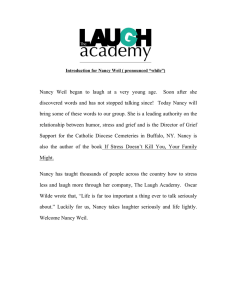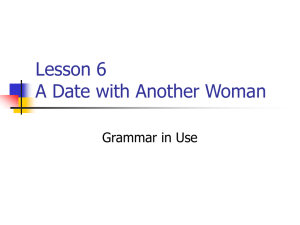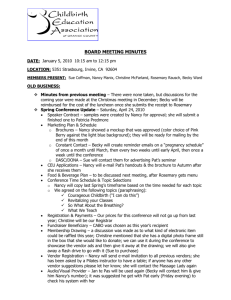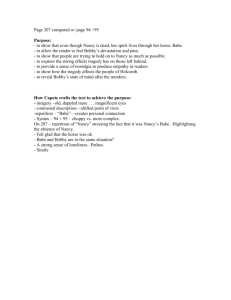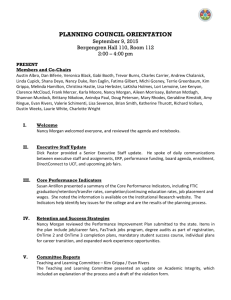Social Sciences, Health, and Education Library NSM Meeting Minutes January 30, 2012
advertisement
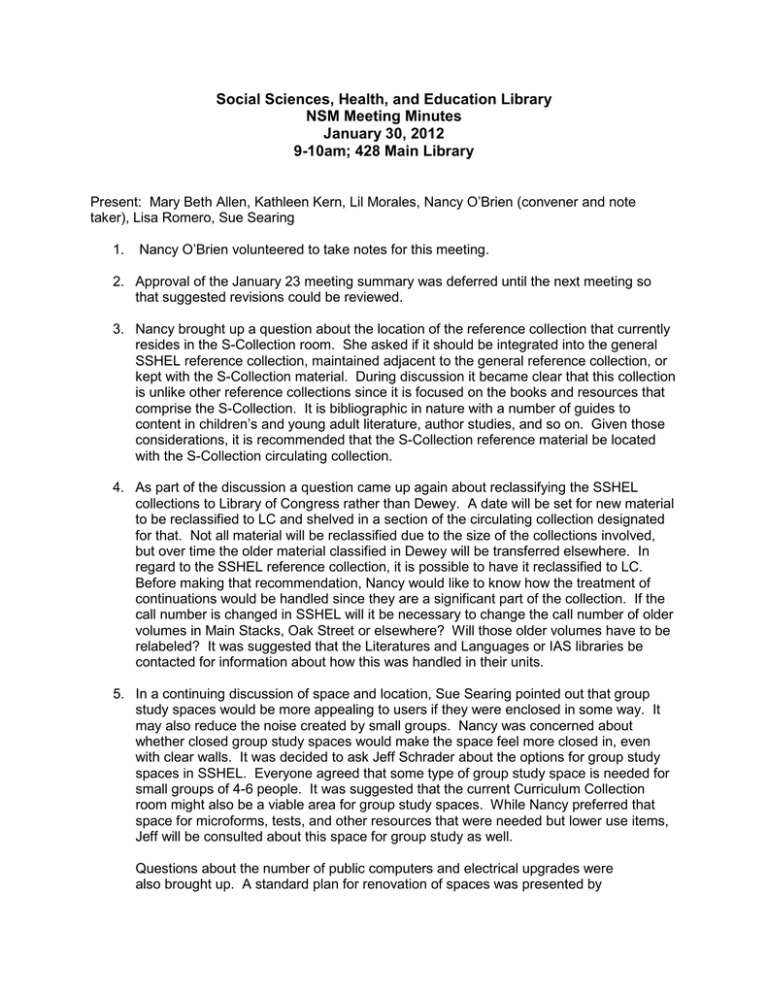
Social Sciences, Health, and Education Library NSM Meeting Minutes January 30, 2012 9-10am; 428 Main Library Present: Mary Beth Allen, Kathleen Kern, Lil Morales, Nancy O’Brien (convener and note taker), Lisa Romero, Sue Searing 1. Nancy O’Brien volunteered to take notes for this meeting. 2. Approval of the January 23 meeting summary was deferred until the next meeting so that suggested revisions could be reviewed. 3. Nancy brought up a question about the location of the reference collection that currently resides in the S-Collection room. She asked if it should be integrated into the general SSHEL reference collection, maintained adjacent to the general reference collection, or kept with the S-Collection material. During discussion it became clear that this collection is unlike other reference collections since it is focused on the books and resources that comprise the S-Collection. It is bibliographic in nature with a number of guides to content in children’s and young adult literature, author studies, and so on. Given those considerations, it is recommended that the S-Collection reference material be located with the S-Collection circulating collection. 4. As part of the discussion a question came up again about reclassifying the SSHEL collections to Library of Congress rather than Dewey. A date will be set for new material to be reclassified to LC and shelved in a section of the circulating collection designated for that. Not all material will be reclassified due to the size of the collections involved, but over time the older material classified in Dewey will be transferred elsewhere. In regard to the SSHEL reference collection, it is possible to have it reclassified to LC. Before making that recommendation, Nancy would like to know how the treatment of continuations would be handled since they are a significant part of the collection. If the call number is changed in SSHEL will it be necessary to change the call number of older volumes in Main Stacks, Oak Street or elsewhere? Will those older volumes have to be relabeled? It was suggested that the Literatures and Languages or IAS libraries be contacted for information about how this was handled in their units. 5. In a continuing discussion of space and location, Sue Searing pointed out that group study spaces would be more appealing to users if they were enclosed in some way. It may also reduce the noise created by small groups. Nancy was concerned about whether closed group study spaces would make the space feel more closed in, even with clear walls. It was decided to ask Jeff Schrader about the options for group study spaces in SSHEL. Everyone agreed that some type of group study space is needed for small groups of 4-6 people. It was suggested that the current Curriculum Collection room might also be a viable area for group study spaces. While Nancy preferred that space for microforms, tests, and other resources that were needed but lower use items, Jeff will be consulted about this space for group study as well. Questions about the number of public computers and electrical upgrades were also brought up. A standard plan for renovation of spaces was presented by Jeff Schrader in the fall (see the October 31, 2011 meeting summary), but the final recommendations will need to include specific numbers of public workstations. Everyone agreed that there is extensive demand for public workstations, especially in such a visible space that is immediately seen when entering the Main Library building. Nancy mentioned that Becky Smith had sent her a message about Becky’s review of journals currently located in the Business and Economics Library. The implication of the message was that these journals would move to SSHEL. Nancy requested a list of the journals and Becky said she would provide one once she completed her review. There was discussion of whether SSHEL was the appropriate location for these journals, with the recognition that print serials still have to be located and managed by a library unit. Some of the BEL journals may be more appropriately housed in libraries such as Grainger, Funk ACES, or Undergraduate, however, depending on the subject focus. If journals formerly located in BEL are transferred to SSHEL it will require additional staffing to manage these materials. 6. Sue Searing discussed her experience with assessing the transition of the LIS Library. She indicated that it was a different experience since it involved a closure rather than a merger. She noted that data currently being collected now such as Sweeps Week statistics, hourly head counts, gate counts, reference interactions, and so on would be helpful for future evaluations. Sue surveyed the faculty users of the LIS Library about 14 months after closure as part of an assessment of services, and recommends that SSHEL implement a similar survey. It may be useful to survey constituencies prior to merger and after the merger. Focus groups are another useful way to gather feedback, and Sue has experience in this area. It may be possible to have the graduate assistant assigned to the Library Assessment Working Group assist in analyzing survey or focus group results. Sue will consult personnel in the Literatures and Languages and IAS libraries regarding assessment methods they may have used. 7. Nancy will contact Jeff with questions from the group. She also encouraged everyone to submit one time collection purchase requests by February 10 to Tom Teper. Mary Beth suggested that some of the unfunded health science request may be relevant for SSHEL and will forward those. 8. The next meeting is scheduled for 9am in 428 Main Library. David Ward will attend in order to discuss the intersection of the NSM Reference initiative and the NSM SSHEL services program.

